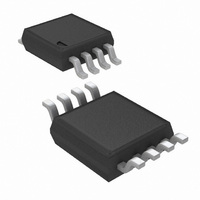LM3488MM/NOPB National Semiconductor, LM3488MM/NOPB Datasheet - Page 18

LM3488MM/NOPB
Manufacturer Part Number
LM3488MM/NOPB
Description
IC CTRLR SWITCH REG N-CH 8-MSOP
Manufacturer
National Semiconductor
Type
Step-Up (Boost), Flyback, Sepicr
Datasheet
1.LM3488MMNOPB.pdf
(24 pages)
Specifications of LM3488MM/NOPB
Internal Switch(s)
No
Synchronous Rectifier
No
Number Of Outputs
1
Voltage - Output
Adj to 1.26V
Current - Output
1A
Frequency - Switching
100kHz ~ 1MHz
Voltage - Input
2.97 ~ 40 V
Operating Temperature
-40°C ~ 125°C
Mounting Type
Surface Mount
Package / Case
8-MSOP, Micro8™, 8-uMAX, 8-uSOP,
Lead Free Status / RoHS Status
Lead free / RoHS Compliant
Power - Output
-
Other names
LM3488MM
LM3488MM
LM3488MMTR
LM3488MM
LM3488MMTR
Available stocks
Company
Part Number
Manufacturer
Quantity
Price
Company:
Part Number:
LM3488MM/NOPB
Manufacturer:
TI
Quantity:
15 540
www.national.com
2.
3.
4.
5.
The off-state voltage of the MOSFET is approximately equal
to the output voltage. V
greater than the output voltage. The power losses in the
MOSFET can be categorized into conduction losses and ac
switching or transition losses. R
the conduction losses. The conduction loss, P
I
is given by:
where D
The turn-on and turn-off transitions of a MOSFET require
times of tens of nano-seconds. C
estimate the large instantaneous power loss that occurs dur-
ing these transitions.
The amount of gate current required to turn the MOSFET on
can be calculated using the formula:
The required gate drive power to turn the MOSFET on is equal
to the switching frequency times the energy required to deliver
the charge to bring the gate charge voltage to V
trical characteristics and typical performance characteristics
for the drive voltage specification).
INPUT CAPACITOR SELECTION
Due to the presence of an inductor at the input of a boost
converter, the input current waveform is continuous and tri-
angular, as shown in
input capacitor sees fairly low ripple currents. However, as the
input capacitor gets smaller, the input ripple goes up. The rms
current in the input capacitor is given by:
Designing SEPIC Using LM3488
Since the LM3488 controls a low-side N-Channel MOSFET,
it can also be used in SEPIC (Single Ended Primary Induc-
tance Converter) applications. An example of SEPIC using
LM3488 is shown in
output voltage can be higher or lower than the input voltage.
The SEPIC uses two inductors to step-up or step-down the
input voltage. The inductors L1 and L2 can be two discrete
inductors or two windings of a coupled transformer since
equal voltages are applied across the inductor throughout the
switching cycle. Using two discrete inductors allows use of
catalog magnetics, as opposed to a custom transformer. The
input ripple can be reduced along with size by using the cou-
pled windings of transformer for L1 and L2.
2
R loss across the MOSFET. The maximum conduction loss
On-resistance, R
Total gate charge, Q
Reverse transfer capacitance, C
Maximum drain to source voltage, V
MAX
is the maximum duty cycle.
Figure
P
Figure
DS
Drive
(ON)
I
g
DS(MAX)
G
= F
= Q
11. The inductor ensures that the
14. As shown in
S
g
.Q
DS(ON)
.F
of the MOSFET must be
RSS
g
S
.V
RSS
DR
and Q
is needed to estimate
DS(MAX)
g
Figure
are needed to
DR
COND
(see elec-
, is the
14, the
18
The input capacitor should be capable of handling the rms
current. Although the input capacitor is not as critical in a
boost application, low values can cause impedance interac-
tions. Therefore a good quality capacitor should be chosen in
the range of 100µF to 200µF. If a value lower than 100µF is
used, then problems with impedance interactions or switching
noise can affect the LM3478. To improve performance, es-
pecially with V
20Ω resistor at the input to provide a RC filter. The resistor is
placed in series with the V
attached to the V
ceramic capacitor is necessary in this configuration. The bulk
input capacitor and inductor will connect on the other side of
the resistor with the input power supply.
OUTPUT CAPACITOR SELECTION
The output capacitor in a boost converter provides all the out-
put current when the inductor is charging. As a result it sees
very large ripple currents. The output capacitor should be ca-
pable of handling the maximum rms current. The rms current
in the output capacitor is:
Where
and D, the duty cycle is equal to (V
The ESR and ESL of the output capacitor directly control the
output ripple. Use capacitors with low ESR and ESL at the
output for high efficiency and low ripple voltage. Surface
Mount tantalums, surface mount polymer electrolytic and
polymer tantalum, Sanyo- OSCON, or multi-layer ceramic ca-
pacitors are recommended at the output.
Due to the presence of the inductor L1 at the input, the SEPIC
inherits all the benefits of a boost converter. One main ad-
vantage of SEPIC over boost converter is the inherent input
to output isolation. The capacitor CS isolates the input from
the output and provides protection against shorted or mal-
functioning load. Hence, the A SEPIC is useful for replacing
boost circuits when true shutdown is required. This means
that the output voltage falls to 0V when the switch is turned
off. In a boost converter, the output can only fall to the input
voltage minus a diode drop.
The duty cycle of a SEPIC is given by:
FIGURE 13. Reducing IC Input Noise
IN
IN
below 8 volts, it is recommended to use a
pin directly (see
IN
pin with only a bypass capacitor
Figure
OUT
− V
13). A 0.1µF or 1µF
IN
10138893
)/V
OUT
.












